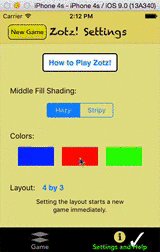Sharing an Image between two viewControllers during a transition animation
It's probably two different views and an animated snapshot view. In fact, this is exactly why snapshot views were invented.
That's how I do it in my app. Watch the movement of the red rectangle as the presented view slides up and down:

It looks like the red view is leaving the first view controller and entering the second view controller, but it's just an illusion. If you have a custom transition animation, you can add extra views during the transition. So I create a snapshot view that looks just like the first view, hide the real first view, and move the snapshot view — and then remove the snapshot view and show the real second view.
Same thing here (such a good trick that I use it in a lot of apps): it looks like the title has come loose from the first view controller table view cell and slid up to into the second view controller, but it's just a snapshot view:

Here is what we did in order to achieve floating screenshot of the view during animated transition (Swift 4):
Idea behind:
- Source and destination view controllers conforms to
InterViewAnimatableprotocol. We are using this protocol to find source and destination views. - Then we creating snapshots of those views and hiding them. Instead, at the same position snapshots are shown.
- Then we animating snapshots.
- At the end of transition we unhiding destination view.
As result it looks like source view is flying to destination.
File: InterViewAnimation.swift
// TODO: In case of multiple views, add another property which will return some unique string (identifier).
protocol InterViewAnimatable {
var targetView: UIView { get }
}
class InterViewAnimation: NSObject {
var transitionDuration: TimeInterval = 0.25
var isPresenting: Bool = false
}
extension InterViewAnimation: UIViewControllerAnimatedTransitioning {
func transitionDuration(using: UIViewControllerContextTransitioning?) -> TimeInterval {
return transitionDuration
}
func animateTransition(using transitionContext: UIViewControllerContextTransitioning) {
let containerView = transitionContext.containerView
guard
let fromVC = transitionContext.viewController(forKey: .from),
let toVC = transitionContext.viewController(forKey: .to) else {
transitionContext.completeTransition(false)
return
}
guard let fromTargetView = targetView(in: fromVC), let toTargetView = targetView(in: toVC) else {
transitionContext.completeTransition(false)
return
}
guard let fromImage = fromTargetView.caSnapshot(), let toImage = toTargetView.caSnapshot() else {
transitionContext.completeTransition(false)
return
}
let fromImageView = ImageView(image: fromImage)
fromImageView.clipsToBounds = true
let toImageView = ImageView(image: toImage)
toImageView.clipsToBounds = true
let startFrame = fromTargetView.frameIn(containerView)
let endFrame = toTargetView.frameIn(containerView)
fromImageView.frame = startFrame
toImageView.frame = startFrame
let cleanupClosure: () -> Void = {
fromTargetView.isHidden = false
toTargetView.isHidden = false
fromImageView.removeFromSuperview()
toImageView.removeFromSuperview()
}
let updateFrameClosure: () -> Void = {
// https://stackoverflow.com/a/27997678/1418981
// In order to have proper layout. Seems mostly needed when presenting.
// For instance during presentation, destination view does'n account navigation bar height.
toVC.view.setNeedsLayout()
toVC.view.layoutIfNeeded()
// Workaround wrong origin due ongoing layout process.
let updatedEndFrame = toTargetView.frameIn(containerView)
let correctedEndFrame = CGRect(origin: updatedEndFrame.origin, size: endFrame.size)
fromImageView.frame = correctedEndFrame
toImageView.frame = correctedEndFrame
}
let alimationBlock: (() -> Void)
let completionBlock: ((Bool) -> Void)
fromTargetView.isHidden = true
toTargetView.isHidden = true
if isPresenting {
guard let toView = transitionContext.view(forKey: .to) else {
transitionContext.completeTransition(false)
assertionFailure()
return
}
containerView.addSubviews(toView, toImageView, fromImageView)
toView.frame = CGRect(origin: .zero, size: containerView.bounds.size)
toView.alpha = 0
alimationBlock = {
toView.alpha = 1
fromImageView.alpha = 0
updateFrameClosure()
}
completionBlock = { _ in
let success = !transitionContext.transitionWasCancelled
if !success {
toView.removeFromSuperview()
}
cleanupClosure()
transitionContext.completeTransition(success)
}
} else {
guard let fromView = transitionContext.view(forKey: .from) else {
transitionContext.completeTransition(false)
assertionFailure()
return
}
containerView.addSubviews(toImageView, fromImageView)
alimationBlock = {
fromView.alpha = 0
fromImageView.alpha = 0
updateFrameClosure()
}
completionBlock = { _ in
let success = !transitionContext.transitionWasCancelled
if success {
fromView.removeFromSuperview()
}
cleanupClosure()
transitionContext.completeTransition(success)
}
}
// TODO: Add more precise animation (i.e. Keyframe)
if isPresenting {
UIView.animate(withDuration: transitionDuration, delay: 0, options: .curveEaseIn,
animations: alimationBlock, completion: completionBlock)
} else {
UIView.animate(withDuration: transitionDuration, delay: 0, options: .curveEaseOut,
animations: alimationBlock, completion: completionBlock)
}
}
}
extension InterViewAnimation {
private func targetView(in viewController: UIViewController) -> UIView? {
if let view = (viewController as? InterViewAnimatable)?.targetView {
return view
}
if let nc = viewController as? UINavigationController, let vc = nc.topViewController,
let view = (vc as? InterViewAnimatable)?.targetView {
return view
}
return nil
}
}
Usage:
let sampleImage = UIImage(data: try! Data(contentsOf: URL(string: "https://placekitten.com/320/240")!))
class InterViewAnimationMasterViewController: StackViewController {
private lazy var topView = View().autolayoutView()
private lazy var middleView = View().autolayoutView()
private lazy var bottomView = View().autolayoutView()
private lazy var imageView = ImageView(image: sampleImage).autolayoutView()
private lazy var actionButton = Button().autolayoutView()
override func setupHandlers() {
actionButton.setTouchUpInsideHandler { [weak self] in
let vc = InterViewAnimationDetailsViewController()
let nc = UINavigationController(rootViewController: vc)
nc.modalPresentationStyle = .custom
nc.transitioningDelegate = self
vc.handleClose = { [weak self] in
self?.dismissAnimated()
}
// Workaround for not up to date laout during animated transition.
nc.view.setNeedsLayout()
nc.view.layoutIfNeeded()
vc.view.setNeedsLayout()
vc.view.layoutIfNeeded()
self?.presentAnimated(nc)
}
}
override func setupUI() {
stackView.addArrangedSubviews(topView, middleView, bottomView)
stackView.distribution = .fillEqually
bottomView.addSubviews(imageView, actionButton)
topView.backgroundColor = UIColor.red.withAlphaComponent(0.5)
middleView.backgroundColor = UIColor.green.withAlphaComponent(0.5)
bottomView.layoutMargins = UIEdgeInsets(horizontal: 15, vertical: 15)
bottomView.backgroundColor = UIColor.yellow.withAlphaComponent(0.5)
actionButton.title = "Tap to perform Transition!"
actionButton.contentEdgeInsets = UIEdgeInsets(dimension: 8)
actionButton.backgroundColor = .magenta
imageView.layer.borderWidth = 2
imageView.layer.borderColor = UIColor.magenta.withAlphaComponent(0.5).cgColor
}
override func setupLayout() {
var constraints = LayoutConstraint.PinInSuperView.atCenter(imageView)
constraints += [
LayoutConstraint.centerX(viewA: bottomView, viewB: actionButton),
LayoutConstraint.pinBottoms(viewA: bottomView, viewB: actionButton)
]
let size = sampleImage?.size.scale(by: 0.5) ?? CGSize()
constraints += LayoutConstraint.constrainSize(view: imageView, size: size)
NSLayoutConstraint.activate(constraints)
}
}
extension InterViewAnimationMasterViewController: InterViewAnimatable {
var targetView: UIView {
return imageView
}
}
extension InterViewAnimationMasterViewController: UIViewControllerTransitioningDelegate {
func animationController(forPresented presented: UIViewController, presenting: UIViewController, source: UIViewController) -> UIViewControllerAnimatedTransitioning? {
let animator = InterViewAnimation()
animator.isPresenting = true
return animator
}
func animationController(forDismissed dismissed: UIViewController) -> UIViewControllerAnimatedTransitioning? {
let animator = InterViewAnimation()
animator.isPresenting = false
return animator
}
}
class InterViewAnimationDetailsViewController: StackViewController {
var handleClose: (() -> Void)?
private lazy var imageView = ImageView(image: sampleImage).autolayoutView()
private lazy var bottomView = View().autolayoutView()
override func setupUI() {
stackView.addArrangedSubviews(imageView, bottomView)
stackView.distribution = .fillEqually
imageView.contentMode = .scaleAspectFit
imageView.layer.borderWidth = 2
imageView.layer.borderColor = UIColor.purple.withAlphaComponent(0.5).cgColor
bottomView.backgroundColor = UIColor.blue.withAlphaComponent(0.5)
navigationItem.leftBarButtonItem = BarButtonItem(barButtonSystemItem: .done) { [weak self] in
self?.handleClose?()
}
}
}
extension InterViewAnimationDetailsViewController: InterViewAnimatable {
var targetView: UIView {
return imageView
}
}
Reusable extensions:
extension UIView {
// https://medium.com/@joesusnick/a-uiview-extension-that-will-teach-you-an-important-lesson-about-frames-cefe1e4beb0b
public func frameIn(_ view: UIView?) -> CGRect {
if let superview = superview {
return superview.convert(frame, to: view)
}
return frame
}
}
extension UIView {
/// The method drawViewHierarchyInRect:afterScreenUpdates: performs its operations on the GPU as much as possible
/// In comparison, the method renderInContext: performs its operations inside of your app’s address space and does
/// not use the GPU based process for performing the work.
/// https://stackoverflow.com/a/25704861/1418981
public func caSnapshot(scale: CGFloat = 0, isOpaque: Bool = false) -> UIImage? {
var isSuccess = false
UIGraphicsBeginImageContextWithOptions(bounds.size, isOpaque, scale)
if let context = UIGraphicsGetCurrentContext() {
layer.render(in: context)
isSuccess = true
}
let image = UIGraphicsGetImageFromCurrentImageContext()
UIGraphicsEndImageContext()
return isSuccess ? image : nil
}
}
Result (gif animation):
